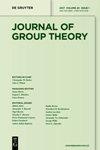Graphical complexes of groups
IF 0.5
3区 数学
Q4 MATHEMATICS
引用次数: 0
Abstract
Abstract We introduce graphical complexes of groups, which can be thought of as a generalisation of Coxeter systems with 1-dimensional nerves. We show that these complexes are strictly developable, and we equip the resulting Basic Construction with three structures of non-positive curvature: piecewise linear群的图形复合体
摘要:我们引入群的图形复合体,它可以被认为是具有一维神经的Coxeter系统的推广。我们证明了这些复合体是严格可展的,并且我们给所得到的基本结构配备了三个非正曲率的结构:分段线性CAT¹(0)\ mathm {CAT}(0), C²(6)C(6)图形小消去,和一个收缩结构。然后,我们利用这些结构来建立这些配合物的基本基团的各种性质,如双自动性和Tits选择性。我们分离出一个容易检验的条件,暗示了基本群的双曲性,并构造了一些非双曲性的例子。我们还简要地讨论了C(4) C(4) - T(4) T(4)群的图解复合体的平行理论,并概述了它们的基本性质。
本文章由计算机程序翻译,如有差异,请以英文原文为准。
求助全文
约1分钟内获得全文
求助全文
来源期刊

Journal of Group Theory
数学-数学
CiteScore
1.00
自引率
0.00%
发文量
45
审稿时长
6 months
期刊介绍:
The Journal of Group Theory is devoted to the publication of original research articles in all aspects of group theory. Articles concerning applications of group theory and articles from research areas which have a significant impact on group theory will also be considered.
Topics:
Group Theory-
Representation Theory of Groups-
Computational Aspects of Group Theory-
Combinatorics and Graph Theory-
Algebra and Number Theory
 求助内容:
求助内容: 应助结果提醒方式:
应助结果提醒方式:


